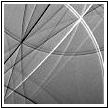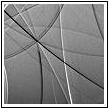 KSLStrain
KSLStrain

Profile-based
determination of strain
KSLStrain allows for determination of strain with respect to
reference patterns. The precision of this approach is better than that
of the standard refinement of lattice parameters because it compares
profiles of lines in the investigated and reference patterns.
For that, the investigated pattern must correspond to (almost) the same
orientation as the reference pattern.
The standard steps are as follows:
- Load and index the reference pattern.
- Activate "Profile matching" frame (in "File" menu).
- Click on the "Mark" button in "Profile matching" frame;
this will mark the conics of the reference pattern
simulated with the current ("updated") lattice parameters.
The density of the disks is controlled by
the "step size" button ("5") in the "Profile matching" frame.
- Remove short conics and those, which are weak
in the investigated pattern.
- Click on the "Save" button in "Profile matching" frame;
this will save the positions of the conics and profiles
collected at the marking disks to a file named
"filename of the reference pattern"_Profiles.txt.
- Load the investigated pattern by clicking on the
"Pattern" button at the bottom of the main window
or by selecting "Open pattern" in the "File" menu.
- Click on the "Load" button in "Profile matching" frame;
this will allow for opening a file with the previously
saved conics and profiles of the reference pattern
("_Profiles.txt").
- Use the command buttons marked by arrows and the one marked
by a circle in the in "Profile matching" frame to fit the
loaded conics to the conics of the currently displayed pattern. The
step size is controlled by the "step size" button ("5")
in the "Profile matching" frame.
If the check box in "Profile matching" frame is checked,
the program will display (at the lower right corner of the main window)
the average correlation coefficient of the reference
and current profiles. (Slow!) It is expected that the discrepancy
between the conics is small.
- At this point, one can fit all profiles either
manually by using the profiles for each marking disk
(right click on the disk, the reference and the current
profile are displayed in the window);
- or semi-automatically by clicking on the "Fit" button
in "Profile matching" frame; this will fit the profiles
by maximization of the correlation coefficient; if the upper option
button is selected, the maximum is
determined by a grid search; if the lower option button is selected,
the maximum is determined by function minimization;
the range of the search for the extremum is controlled
by the the "step size" button ("5") in the "Profile matching" frame;
the program will display the average correlation coefficient
(at the lower right corner of the main window or in a message box).
The results of the semiautomatic approach must be manually verified.
The first step is to right-click on the "Show/Hide" button of
the main window to see the largest deviation of a disk from the conic.
If there are difficulties of fitting a profile,
the whole conic can be removed (middle click on the disk). With
right-click on "Fit", the fitting is preceded by automatic elimination
of disk/lines considered to be not suitable for profile matching.
- Once a satisfactory fit for ALL disks is achieved,
one can proceed as in the case of lattice parameter refinement,
i.e., click on "Indexing", "Save data" and "Strain" buttons
of the main window to calculate the strain for the investigated pattern
with respect to the reference pattern.
KSLStrain
v.1.2,
Mar.
2020